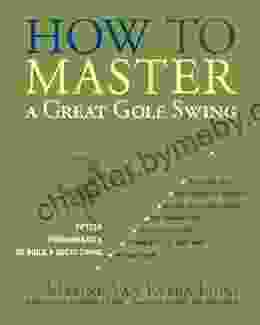How to Master the Perfect Golf Swing: A Comprehensive Guide to Improve Your Game

4.3 out of 5
| Language | : | English |
| File size | : | 9882 KB |
| Text-to-Speech | : | Enabled |
| Screen Reader | : | Supported |
| Enhanced typesetting | : | Enabled |
| Word Wise | : | Enabled |
| Print length | : | 306 pages |
Golf is a challenging yet rewarding sport that requires a combination of skill, technique, and mental focus. Among the fundamental skills in golf, the swing is paramount. A well-executed swing generates power, accuracy, and consistency, leading to improved performance on the course. In this comprehensive guide, we will delve into the intricacies of the golf swing, providing expert insights, step-by-step instructions, and actionable tips to help you master this essential technique. Whether you're a beginner or an experienced golfer seeking to refine your swing, this guide will empower you with the knowledge and skills to elevate your game to the next level.
Understanding the Golf Swing
The golf swing is a complex motion that involves a sequence of coordinated body movements. It can be broadly divided into three phases: the backswing, downswing, and follow-through. Each phase plays a crucial role in determining the power, accuracy, and consistency of your shot.
1. The Backswing
The backswing initiates the golf swing. It begins with the club positioned behind the ball and progresses as you take the club back, away from the ball. The key elements of a good backswing include:
- Maintaining a stable head position - Keeping your eyes focused on the ball - Rotating your shoulders and hips in a synchronized motion - Fully extending your arms and reaching the top of your backswing with the club parallel to the ground
2. The Downswing
The downswing is where power is generated. It starts with the transition from the backswing to the downswing, known as the downswing transition. The downswing involves rotating your hips and shoulders while swinging the club down and through the ball. Key elements to consider during the downswing include:
- Maintaining a good posture and balance - Keeping your head down and your eyes on the ball - Striking the ball with the center of the clubface - Following through with the swing after impact
3. The Follow-Through
The follow-through is the final phase of the golf swing. It begins immediately after impact and continues until the club comes to a complete stop. A proper follow-through helps maintain balance and control after hitting the ball. Key elements of a good follow-through include:
- Rotating your body and swinging the club all the way through - Maintaining your balance and posture - Finishing with the club pointing towards the target
Factors Affecting the Golf Swing
Several factors can influence the quality and consistency of your golf swing. Understanding and addressing these factors can significantly improve your swing technique.
1. Grip
The grip is how you hold the club. There are different grip styles, and finding one that suits you is essential. A proper grip provides stability, control, and allows for a consistent swing.
2. Stance
Your stance refers to the position of your feet and body when addressing the ball. A balanced and stable stance is crucial for a good swing. Factors to consider when setting up your stance include foot placement, knee flexion, and posture.
3. Alignment
Alignment refers to the positioning of your body and the club in relation to the target line. Proper alignment ensures that you are swinging the club on the correct path and aiming towards your intended target.
4. Swing Tempo
Swing tempo refers to the rhythm and pace of your swing. A consistent swing tempo helps you control the clubhead speed and timing, leading to improved accuracy and consistency.
Common Swing Faults and How to Correct Them
Every golfer encounters swing faults at some point. Identifying and correcting these faults is essential for improving your swing technique. Common swing faults include:
1. Over-the-Top Swing
An over-the-top swing occurs when the clubhead travels outside-in on the downswing, leading to a slice or pull shot. To correct this fault, focus on swinging the club more inside-out and keeping your head down through impact.
2. Hook
A hook occurs when the ball curves sharply to the left (for right-handed golfers) due to an excessive inside-out swing path. To correct a hook, try swinging more outside-in and keeping your hands ahead of the clubhead at impact.
3. Slice
A slice is the opposite of a hook and occurs when the ball curves sharply to the right (for right-handed golfers) due to an outside-in swing path. To correct a slice, focus on swinging the club more inside-out and keeping your head down through impact.
Practice and Improvement
Mastering the golf swing requires consistent practice and dedication. Here are some tips for effective practice:
1. Set Realistic Goals
Start with small, achievable goals and gradually increase the difficulty as you improve. This approach helps you stay motivated and focused on making progress.
2. Use Training Aids
Training aids such as swing analyzers, impact bags, and alignment sticks can provide valuable feedback and help you identify areas for improvement.
3. Get Feedback
Seek feedback from a qualified golf instructor or experienced golfer to get an objective assessment of your swing and identify areas for improvement.
4. Practice Regularly
Regular practice is the key to improving your golf swing. Aim for at least 30 minutes of practice several times a week to see consistent progress.
Mastering the golf swing is a journey that requires patience, dedication, and a willingness to learn and improve. By understanding the mechanics of the swing, addressing common faults, and practicing consistently, you can develop a powerful, accurate, and consistent swing that will elevate your game to new heights. Remember to enjoy the process and embrace the challenges along the way. With time and effort, you will unlock the secrets of the perfect golf swing and experience the joy of hitting the ball with precision and confidence.
4.3 out of 5
| Language | : | English |
| File size | : | 9882 KB |
| Text-to-Speech | : | Enabled |
| Screen Reader | : | Supported |
| Enhanced typesetting | : | Enabled |
| Word Wise | : | Enabled |
| Print length | : | 306 pages |
Do you want to contribute by writing guest posts on this blog?
Please contact us and send us a resume of previous articles that you have written.
 Book
Book Novel
Novel Page
Page Chapter
Chapter Text
Text Story
Story Genre
Genre Reader
Reader Library
Library Paperback
Paperback E-book
E-book Magazine
Magazine Newspaper
Newspaper Paragraph
Paragraph Sentence
Sentence Bookmark
Bookmark Shelf
Shelf Glossary
Glossary Bibliography
Bibliography Foreword
Foreword Preface
Preface Synopsis
Synopsis Annotation
Annotation Footnote
Footnote Manuscript
Manuscript Scroll
Scroll Codex
Codex Tome
Tome Bestseller
Bestseller Classics
Classics Library card
Library card Narrative
Narrative Biography
Biography Autobiography
Autobiography Memoir
Memoir Reference
Reference Encyclopedia
Encyclopedia Richard Feinberg
Richard Feinberg Thomas Chatterton Williams
Thomas Chatterton Williams Michael Kagan
Michael Kagan Pam Young
Pam Young Noah Wilson
Noah Wilson Matthew Goodman
Matthew Goodman Michael Reid
Michael Reid Orysia Dawydiak
Orysia Dawydiak William Beebe
William Beebe Mike Bockoven
Mike Bockoven Mercy Fontenot
Mercy Fontenot Mary Ann Fraser
Mary Ann Fraser Mick Kilburn
Mick Kilburn Sophia Joy
Sophia Joy Mary Renault
Mary Renault Matt Fitzgerald
Matt Fitzgerald Matthew K Manning
Matthew K Manning Philip Lee
Philip Lee Paul Chiasson
Paul Chiasson Mike Grist
Mike Grist
Light bulbAdvertise smarter! Our strategic ad space ensures maximum exposure. Reserve your spot today!

 Anthony BurgessUnveiling the Lyrical Essence of Gary Soto's Oranges: A Comprehensive Study...
Anthony BurgessUnveiling the Lyrical Essence of Gary Soto's Oranges: A Comprehensive Study...
 Haruki MurakamiFree Your Feet: To Minimize Impact, Maximize Efficiency, and Discover The...
Haruki MurakamiFree Your Feet: To Minimize Impact, Maximize Efficiency, and Discover The... D'Angelo CarterFollow ·15.3k
D'Angelo CarterFollow ·15.3k Jason ReedFollow ·2.7k
Jason ReedFollow ·2.7k Bernard PowellFollow ·15.5k
Bernard PowellFollow ·15.5k Rubén DaríoFollow ·15k
Rubén DaríoFollow ·15k Ken SimmonsFollow ·18.5k
Ken SimmonsFollow ·18.5k Rob FosterFollow ·5.5k
Rob FosterFollow ·5.5k Derek CookFollow ·5.7k
Derek CookFollow ·5.7k Joshua ReedFollow ·12k
Joshua ReedFollow ·12k

 Henry James
Henry JamesCold War Fighter Pilot Story: A Captivating Tale of...
Enter the Cockpit of...

 Rudyard Kipling
Rudyard KiplingYour Body Your Baby Your Choices: The Essential Guide to...
Pregnancy and...

 Fabian Mitchell
Fabian MitchellMichelle Obama: An Intimate Portrait - A Must-Read for...
Michelle Obama is a prominent figure in...

 Juan Butler
Juan ButlerUncover the Secrets of the Dead Land Warshawski Novels
Prepare to delve...
4.3 out of 5
| Language | : | English |
| File size | : | 9882 KB |
| Text-to-Speech | : | Enabled |
| Screen Reader | : | Supported |
| Enhanced typesetting | : | Enabled |
| Word Wise | : | Enabled |
| Print length | : | 306 pages |












